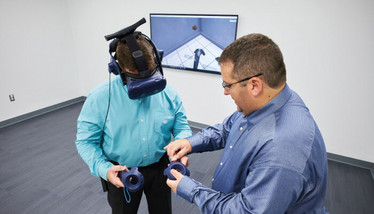
Virtual Reality: Training the Workforce of the Future
Why virtual and augmented technology is the future of training

This article is part of our special focus on "traditional" pharma: The Small Molecule Manufacturer (read more here). You can find more articles from The Small Manufacturer here.

Last year, Thermo Fisher Scientific unveiled a new training facility at their Greenville site in North Carolina that makes use of virtual and augmented reality technologies. The company hopes that this technology will help to reduce training times. “The virtual reality experience is intriguing and novel. Once you put on the goggles, you are transported somewhere else; in this case, to the sterile manufacturing line,” says Michelle Logan, Vice President and General Manager of the Greenville site. “It creates an environment where employees can learn and perform tasks without the risk of a mistake on an actual line.”
Working on a sterile injectable manufacturing line is a complex and demanding job. It typically requires more than a year of training to become proficient at each aspect of production. Traditionally, the person being trained would be provided with numerous documents to study and commit to memory. But in an age where technology is readily available, why not use a more dynamic approach? Virtual reality training has been used in numerous industries; for example, flight simulators help to train pilots and prepare them for emergencies.
“At our training center, we have five virtual reality rooms and 20 people can be trained at a time. We think it should result in significant cost savings per year as a result of the reduced training time, reduced turnover and reductions in deviations,” says Logan. “Our virtual reality module allows the participant to visualize the various functions of a line operator and virtually walk through the steps necessary to perform their job before actually working on the line. This approach is helpful in achieving a level of proficiency much faster than traditional training approaches with fewer deviations. Employees should be able to get up to speed with intimate knowledge of aseptic manufacturing in approximately four months.”

The augmented reality component will be available once the trained employee is working on the line – and can be used if the employee needs guidance or a refresher related to particular steps in the process or to help with troubleshooting. “There is great utility for augmented reality when it is coupled with other technologies, such as manufacturing execution systems, electronic batch records, electronic laboratory notebooks, etc. We envision the employee monitoring batch critical process parameters and accessing equipment controls holographically,” says Logan.
Subject matter experts will also be available to assist the employee remotely using the cameras to see through the employee’s perspective and provide technical support utilizing face-to-face communication, holographic instructions, and additional resources that may be necessary. Also, the use of cameras on the glasses will enable barcodes and QR codes to quickly identify equipment and materials automatically and provide checks for accuracy and fit for use all in the background while the operator works. Spatial mapping will also allow operators to utilize guides to perform a step by step execution of critical, complex processes while also providing key resources available to the operator at a moment’s notice. Thermo Fisher Scientific envisions these applications and much more to be developed over the coming years.
The initial training modules are to prepare employees to work on the steriles manufacturing line in Greenville, but the company expects to add more training modules in the future focused on continuous manufacturing, pre-filled syringes, and labs. “Global organizations should take pride in offering their employees opportunities to step into new roles and assignments that help encourage career growth and advance skills – whether in a different department, or new location,” says Logan. “It’s also important to offer resources that match individual development interests with learning and development options. Our employees have responded enthusiastically to the new technology and the opportunity to advance their skills. It’s very exciting to try out the VR goggles and the experience! In my view, it is important for employees to learn quickly and feel successful – and virtual reality makes this possible. And ultimately, this will help with the company’s overall strategy to expand its capabilities, capacity and talent globally.”

Making great scientific magazines isn’t just about delivering knowledge and high quality content; it’s also about packaging these in the right words to ensure that someone is truly inspired by a topic. My passion is ensuring that our authors’ expertise is presented as a seamless and enjoyable reading experience, whether in print, in digital or on social media. I’ve spent fourteen years writing and editing features for scientific and manufacturing publications, and in making this content engaging and accessible without sacrificing its scientific integrity. There is nothing better than a magazine with great content that feels great to read.



















